Contact Details

Cutting tool and tooling systems specialist Sandvik Coromant is launching GC4330 and GC4340, two new insert grades for steel milling. With the development of advanced production technologies, such as a new substrate, Inveio coating and an improved post-treatment technology, the new grades provide great opportunities to substantially increase tool life and process security compared to the previous generation of grades, GC4230 and GC4240, which will now be superseded.
Manufacturers face many challenges when milling ISO P workpieces. For instance, some hard and abrasive steels can generate wear along the flank face of the insert, especially at higher speeds and with a longer time in cut. Additionally, machining in unstable conditions because of compromised clamping or long overhang elevates the risk of insert chipping, while thermal fluctuation during machining, especially under wet conditions, can cause crack formation and subsequent sudden breakages.
“Our new grades overcome these issues in many ways,” states Magnus Engdahl, product application manager at Sandvik Coromant. “For instance, the optimized Inveio coating increases wear resistance and tool life dramatically, without jeopardizing security. With its unidirectional crystal orientation, the coating has a high resistance to thermal cracks, which in turn promotes long and reliable tool life, a factor further supported by a new post-treatment process that strengthens the insert by modifying its mechanical properties.”
A newly developed substrate provides well-controlled grain size distribution, which results in more reliable and predictable tool behavior. Additionally, consistent tool life is supported with higher narrow edge-rounding (ER) tolerance. Increased tool life will deliver reduced cost per component, while improved process security brings predictable performance and less downtime, not to mention higher component quality.
GC4330 is a medium hard grade and is for roughing to semifinish facemilling, with the tough GC4340 grade for rough shoulder milling and groove milling. Wet and dry machining is supported, although dry machining is recommended.
Both GC4330 and GC4340 are available in the following product families: CoroMill 390 and CoroMill 490 for shoulder milling; CoroMill 345 and CoroMill 745 for facemilling; CoroMill 210 for high-feed milling; CoroMill 200 for profile milling; and CoroMill 331 for grooving and parting off. Although the grades are optimized for steel, they are also suitable for mixed production involving ISO K (cast iron) and ISO M (stainless steel) workpieces.
Related Glossary Terms
- abrasive
abrasive
Substance used for grinding, honing, lapping, superfinishing and polishing. Examples include garnet, emery, corundum, silicon carbide, cubic boron nitride and diamond in various grit sizes.
- facemilling
facemilling
Form of milling that produces a flat surface generally at right angles to the rotating axis of a cutter having teeth or inserts both on its periphery and on its end face.
- gang cutting ( milling)
gang cutting ( milling)
Machining with several cutters mounted on a single arbor, generally for simultaneous cutting.
- grooving
grooving
Machining grooves and shallow channels. Example: grooving ball-bearing raceways. Typically performed by tools that are capable of light cuts at high feed rates. Imparts high-quality finish.
- mechanical properties
mechanical properties
Properties of a material that reveal its elastic and inelastic behavior when force is applied, thereby indicating its suitability for mechanical applications; for example, modulus of elasticity, tensile strength, elongation, hardness and fatigue limit.
- milling
milling
Machining operation in which metal or other material is removed by applying power to a rotating cutter. In vertical milling, the cutting tool is mounted vertically on the spindle. In horizontal milling, the cutting tool is mounted horizontally, either directly on the spindle or on an arbor. Horizontal milling is further broken down into conventional milling, where the cutter rotates opposite the direction of feed, or “up” into the workpiece; and climb milling, where the cutter rotates in the direction of feed, or “down” into the workpiece. Milling operations include plane or surface milling, endmilling, facemilling, angle milling, form milling and profiling.
- parting
parting
When used in lathe or screw-machine operations, this process separates a completed part from chuck-held or collet-fed stock by means of a very narrow, flat-end cutting, or parting, tool.
- tolerance
tolerance
Minimum and maximum amount a workpiece dimension is allowed to vary from a set standard and still be acceptable.
- wear resistance
wear resistance
Ability of the tool to withstand stresses that cause it to wear during cutting; an attribute linked to alloy composition, base material, thermal conditions, type of tooling and operation and other variables.

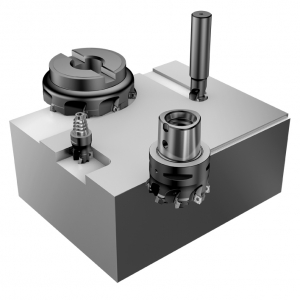
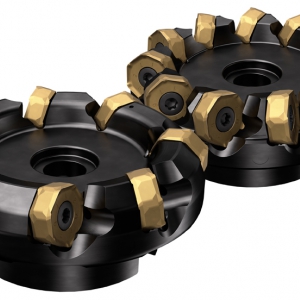
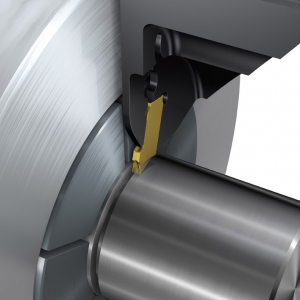
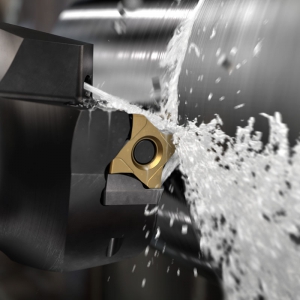

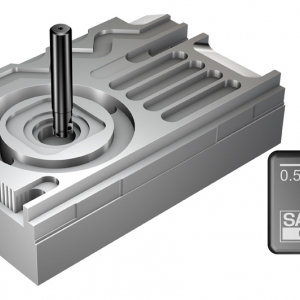
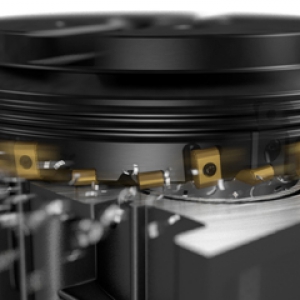
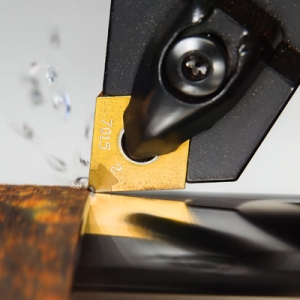

 PRODUCTS
PRODUCTS

